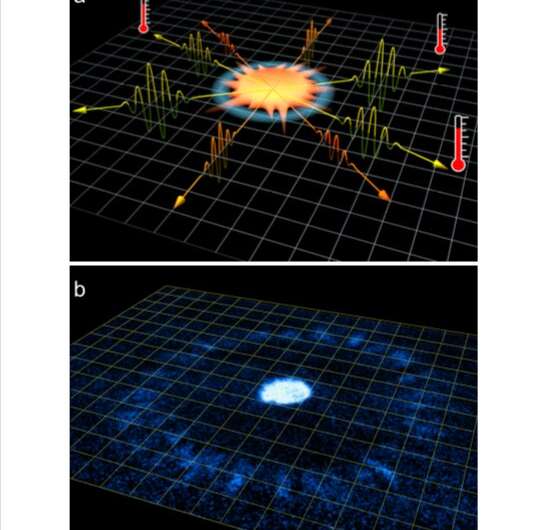June 7, 2019 feature
A quantum simulation of Unruh radiation

Researchers at the University of Chicago (UChicago) have recently reported an experimental observation of a matter field with thermal fluctuations that is in accordance with Unruh's radiation predictions. Their paper, published in Nature Physics, could open up new possibilities for research exploring the dynamics of quantum systems in a curved spacetime.
"Our team at UChicago has been investigating a new quantum phenomena called Bose fireworks that we discovered two years ago," Cheng Chin, one of the researchers who carried out the study, told Phys.org. "Our paper reports its hidden connection to a gravitational phenomenon called Unruh radiation."
The Unruh effect, or Unruh radiation, is closely connected to Hawking radiation. In 1974, theoretical physicist Stephen Hawking predicted that the strong gravitational force near black holes leads to the emission of a thermal radiation of particles, which resembles the heat wave emitted by an oven. This phenomenon remains speculative with no direct experimental confirmation.
A few years later, in 1976, physicist William Unruh hypothesized that a person could observe the same radiation when she is moving with a high acceleration. The equivalence between Hawking and Unruh radiation is based on Einstein's equivalence principle, which has now been confirmed by many experiments.
Despite Unruh's predictions, no one has yet observed Unruh radiation, which is not surprising, as this phenomenon is particularly difficult to capture. In fact, a person would need to endure a G-force of 25 billion billion (25*1018) to see a weak radiation of 1 Kelvin. This is an astounding number when considering that, for instance, the G-force experienced by a fighter jet pilot is no more than 10.
"In our lab, we simulate Unruh physics by precisely modulating a Bose-Einstein condensate with the magnetic field," Chin said. "Even through our sample is not moving, the modulation has the same effect as boosting the sample to an accelerating reference frame. We observe radiation at 2 micro-Kelvin, and the measurement excellently agrees with the Unruh's prediction and confirms the quantum nature of the radiation field."
In their experiment, Chin and his colleagues prepared 60,000 cesium atoms and cooled them to about 10 nano-Kelvin, then started the modulation of the magnetic field. A few milliseconds after the modulation, they observed a thermal emission of atoms in all directions. To confirm the thermal distribution of atoms, the researchers collected a larger number of samples and showed that the atom number fluctuates precisely according to the thermal Boltzmann distribution.
"The temperatures we extracted from the images agree excellently with Unruh's prediction," Chin said. "In addition to the thermal distribution, we also observe the spatial and temporal coherence of the matter wave emission. The coherence is the hallmark of quantum mechanics and reveals that Unruh radiation originates from quantum mechanics. This is in sharp contrast to classical thermal radiation sources, like an oven or sunlight, which come from thermal equilibrium."
Essentially, Chin and his colleagues observed a matter wave field using a framework for quantum physics simulations in non-inertial frames. They observed that this matter wave's fluctuations, as well as long-range phase coherence and its temporal coherence are aligned with Unruh's predictions.
The study carried out by the team at UChicago was funded by the National Science Foundation, Army Research Office and Chicago MRSEC. In the future, their observations could have important implications for the study of quantum phenomena in a curved spacetime.
"Our method applies to generic quantum states in non-inertial reference frames. In our future work, we wish to identify novel quantum phenomena in curved spacetimes," Chin said. "There has been much discussion whether Einstein's general relativity is compatible with quantum mechanics. There are proposals, speculations and even paradox, and we wish to carry out experiments that can help to better understand how quantum mechanics works in curved spacetimes."
More information: Jiazhong Hu et al. Quantum simulation of Unruh radiation, Nature Physics (2019). DOI: 10.1038/s41567-019-0537-1
Journal information: Nature Physics
© 2019 Science X Network




















